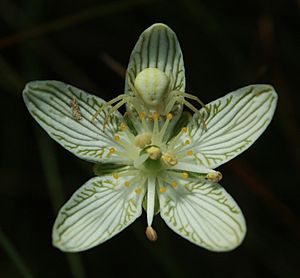Fen grass of Parnassus facts for kids
Quick facts for kids Fen grass of Parnassus |
|
|---|---|
 |
|
| Parnassia glauca flower with a crab spider in Quebec, Canada. | |
| Scientific classification | |
| Genus: |
Parnassia
|
| Species: |
glauca
|
| Synonyms | |
|
Parnassia americana Muhl. |
|
The Parnassia glauca, often called fen grass of Parnassus, is a beautiful flowering plant. It is a type of herb, which means it has soft stems instead of woody ones. This plant belongs to a group of plants known as the Parnassia genus.
About the Fen Grass of Parnassus
The fen grass of Parnassus is a unique plant. It gets its name from where it likes to grow. "Fen" is a type of wetland with special wet, spongy soil. The plant's scientific name, Parnassia glauca, helps scientists around the world know exactly which plant they are talking about.
Where It Grows
This plant is native to parts of North America. You can find it growing naturally in the northeastern United States and southeastern Canada.
It loves to live in wet places. Its favorite spots include fens, which are like grassy, marshy areas. It also grows along the edges of other wetlands. You might see it on the shores of rivers and lakes, or in areas near rivers that sometimes flood, called floodplains.
The fen grass of Parnassus prefers a special kind of soil. It likes "basic soils," which means the soil has a high pH. Think of pH as a way to measure how acidic or basic something is. A high pH means the soil is more basic, which is just right for this plant.
What It Looks Like
The flower of the Parnassia glauca is quite interesting. It has five main parts that are alike, which scientists call "5-merous." This means it has five petals, which are the colorful parts of the flower. It also has five sepals, which are like small green leaves that protect the bud before it opens.
Inside the flower, there are five special parts called "sterile stamens." These stamens don't produce pollen. Each of these sterile stamens splits into three smaller parts near its base. This makes it look like the flower has 15 of these sterile stamens in total!
At the very top of each of these small stamen branches, there's a tiny yellow ball. It looks just like a drop of nectar, which is a sweet liquid that attracts pollinators. This clever trick helps to draw insects to the flower.
The five white petals of the flower often have green lines or veins. These green lines might act like "landing strips" or guides for insects, showing them where to go to help pollinate the flower.
The leaves of the plant are simple and smooth around the edges. They grow only at the very bottom of the plant, close to the ground. After the flower is pollinated, it forms a dry seed pod called a capsule. When the seeds are ready, this capsule splits open to release them.

